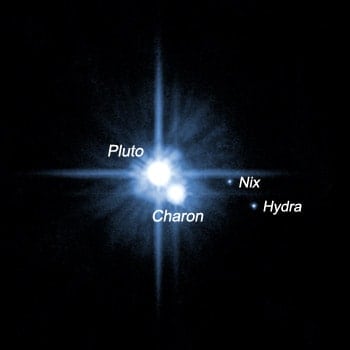Two new small moons of Pluto, which were discovered by the Hubble Space Telescope last year, have been officially christened Hydra and Nix. Previously they were known rather boringly as P1 and P2. The new names were approved this week by the International Astronomical Union (IUA) -- the official body that assigns names to celestial objects.

First photographed by Hubble in May 2005, Hydra and Nix are about 5000 times fainter than Pluto and roughly two to three times further from the planet than its largest moon Charon, which was discovered in 1978. The more distant of the two new moons (P1) is now known as Hydra, while Nix is the new name for the inner satellite (P2).
Although the members of the team who discovered the moon wanted to call the inner satellite Nyx, that name was already bagged by asteroid 3908. The IAU therefore changed Nyx to its Egyptian equivalent, Nix.
In Greek mythology, Nyx was the goddess of darkness and night and so is a good name for a moon orbiting Pluto — the god of the underworld. Nyx was also the mother of Charon, the sulky old boatman who ferried the dead into Hades. This name therefore alludes to the theory that a giant impact created Pluto’s satellites and that Charon was created from the same material as Nix. Hydra, meanwhile, was a nine-headed serpent monster, loosely related to the fact that moon is orbiting Pluto, the ninth planet in the solar system.
There are further connections too. Just as Pluto’s name begins with the letters “P” and “l” to pay tribute to astronomer Percival Lowell, whose work led to the discovery of the planet in 1930, so Nix and Hydra honour the “New Horizons” mission because they start with the letters “N” and “H”. New Horizons, which was launched in January this year, is the first spacecraft to visit Pluto and its moons. If you can bear any more of this, note that the first letter of Hydra also honours the Hubble Space Telescope.



